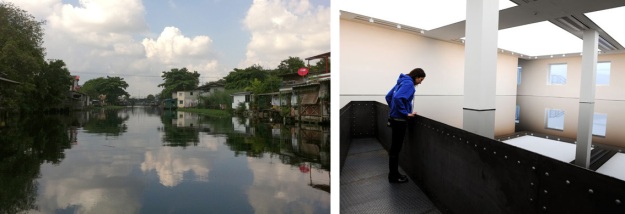 Before our final presentation in London we were each asked to state a few sentences of what we learned from the field experience in Bangkok.
Before our final presentation in London we were each asked to state a few sentences of what we learned from the field experience in Bangkok.
I learned the limitations of design. I saw that design strategies cannot stand alone, they must be linked with both top-down and bottom-up processes that are working to address urban inequalities. It became clear that even the most inspired design strategies must be supplemented by municipal policies that expose obstacles and address vulnerabilities, at the local and metropolitan level. In order for transformation to take place we must always close the loop through policy change.
While my reflection from Bangkok is accurate — I feel that my initial response was a bit naïve. I did not acknowledge a very serious obstacle in the relationship between the role of design and the process of transformation. Yes, it is true that design cannot stand alone. And, social and spatial transformations cannot take place without design. However, the points of insertion or the room of maneuver for spatial interventions to be significantly influential or even fully involved in the continuous process of urban transformation is highly limited. In Bangkok and within the larger context of urban practitioners it is difficult to determine how it is possible for the participation of architects, landscape architects and urban designers to be fully embedded in the processes of urban change.
All around the world we find an overabundance of design ideas and spatial manifestations of human ingenuity relating to the topic of housing. Yet the implementation of design and the knowledge transfer of these ideas is highly ineffective. In citing an example from Bangkok — we saw how interstitial spaces could be used as an untapped resource of land for the urban poor. The use of interstitial spaces under the flyovers would increase the provision of housing and the productivity of space within the city centre. Yet the implementation of these potential design ideas is confronted by an endless list of challenges on a multiple scales (e.g. on the part of private owners, government policies, global economic pressures, ect). In examining these challenges it is important to ask — who is meant to be responsible for overcoming all of these obstacles in order to make it possible for the greater empowerment of design?
In examining the case of the Baan Mankong Programme —the conflict between design and transformation is especially evident. It was that clear social mobilization was essential to their process of urban transformation. The determination of both individuals and group collaborations created networks of knowledge share around the allocation of secure land and housing for the urban poor. However, their process of transformation lacked the continuous presence of architects, builders and experts of urban infrastructure. In consequence, there was an overemphasis on the design of individual housing plots with little connection to communal space or existing resources. The role of architects at the community and metropolitan scale could have facilitated much greater flexibility of housing typology and efficiency of land use approach. A greater empowerment of design is essential not merely for aesthetic or productive purposes, but because design thinking teaches people to reinterpret existing problems and develop solutions that were previously inconceivable. Like the multiplier effect created through social mobilization and the production of knowledge — I argue that design thinking could re-shape normative ideas of knowledge share or how spatial transformations are taking place. Perhaps, developing this balance between design thinking and social mobilization is difficult to implement. But it is clear that the process of reaching scale cannot be achieved without this balance.
My field experience in Bangkok gave me an understanding of the multiscalarity of urban challenges, particularly relating to the allocation of secure land and the provision of housing for the urban poor. However, I am still searching for a clear definition of the relationship between the practitioner and the mode of intervention. Within the context of Bangkok and beyond I continue to question —
Can the practioner help to facilitate a greater balance between design thinking and social mobilization amongst the various actors involved in the process of transformation? As practioners how are we meant to shift our spatial strategies to better respond to more embryonic programmes versus programmes that are much more mature and have been part of urban processes for many years? And, how is it possible for the practitioner to be part of propelling long-term sustainable change when the design intervention is only taking place a specific point in time?
For me, the limitations of the field experience in Bangkok and the course at large surround the topic of the role of the practitioner. The challenge of implementing change on small and large scales calls for a responsiveness that is currently inconceivable in many existing legal, political and economic frameworks. These limitations make it clear that the role of the urban practitioner is evolving. But it is still uncertain of how those responsibilities are being defined and what is the meaning of working at the juncture of design and development in cities like Bangkok. I am leaving this experience with more questions than answers. But perhaps more importantly — the course has led me to develop a perspective of urban processes that is more critical and probing in nature. I look forward to discovering how this will inform my work over time.


















